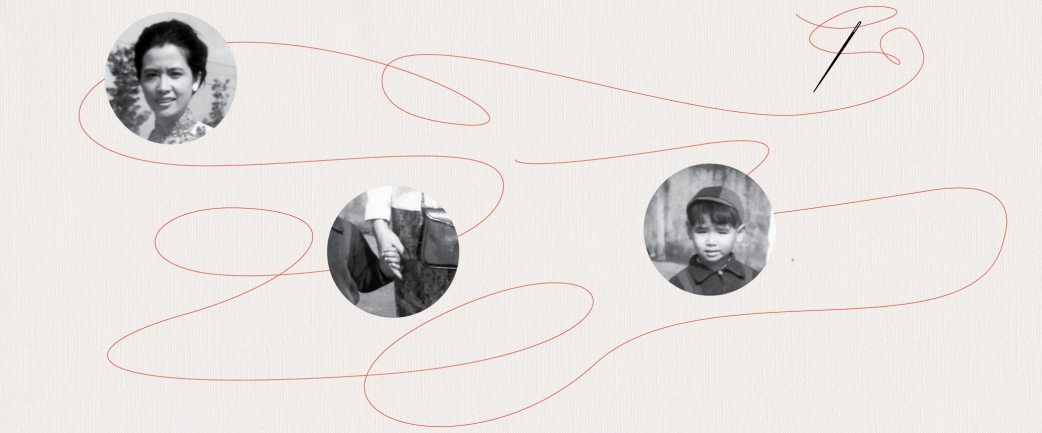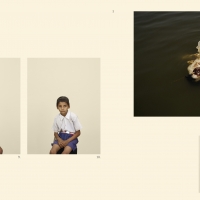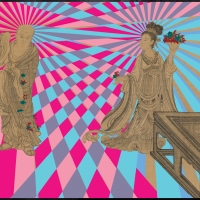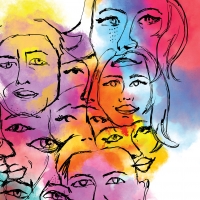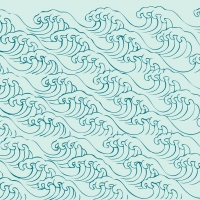
The artist reflects on the lasting impact of an early memory and his mother’s gift
Lee Mingwei creates experiences grounded in gift giving, trust, and the element of the unknown. In The Letter Writing Project (1998–present), museum visitors are invited to write a letter to a deceased or absent loved one. They can leave the letter behind unsealed for others to read or include an address for the museum to post their message. Stone Journey (2010) comprises two stones: one is a Neolithic stone and the other a bronze copy. The artist instructs the owner to discard one of the stones to complete the project, calling into question issues of ownership and value. Both works are featured in the Rubin Museum’s exhibition Measure Your Existence, curated by Christine Starkman, which explores duration, memory, and disappearance as markers of the fleeting nature of our lives.

Christine Starkman: When I asked you for an image, I was so happy to receive the photograph of you with your mother. Please walk me through the day when the photograph was taken.
Lee Mingwei: I remember that day very vividly. It was the first day of kindergarten. For the longest time, I did not want to go to school. I wanted to spend time with the dogs and cats and kids around the neighborhood. I also cherished the time spent with my mom. I am very close to my mom. My mother is a very clever person. She spent six months making everything I was going to wear that day. Everything you see in the picture, my mother sewed with her own hands: the hat, little jacket, pants—everything she made especially for me for that day.
She told me, “I understand if you don’t want to go to school. I also understand that you will be thinking of me, and I will be thinking of you. I will make the clothing you will wear for your first day of school. When you think of me, I am hugging you. I am next to you. So don’t be afraid, and have fun with your classmates. I am with you.” I remember at the time I still didn’t want to go. I was afraid and I had a lot of anxiety leaving my mom. On the other hand, I was also very curious about the next stage of my life.
Why did you choose this particular picture when I asked you to select an image related to impermanence, change, disappearance, or loss?
I have many pictures, but this is probably the only one of my mother and myself at a young age. It was a very particular day of my life.
Love and gift giving seem to be sources and inspiration for the way you work.
Yes, the gift has many layers. For example, the obvious gift is from mother to child.
Yes.
My mother’s thoughtfulness. She could have just brought me to school without creating this special moment to remember. But instead she made elaborate plans and a situation to encourage me to go to school. It is a very beautiful gift, and I have benefited from it ever since. My mother gave me a beautiful memory of my first day of school. Having both my parents there and wearing the beautiful outfit made me feel very special.

In your projects the museum visitor is often offered a gift. They participate in the gift-giving situation, in a way creating another memory for them to remember.
Yes. It is almost intuitive. That is where all my work comes from. This wanting to be generous and kind to another person.
Does the encounter you set up in your work always have a sense of uncomfortableness?
The work always has an element of challenge and fear. I think with all my work there needs to be tension. The tension makes it a much more complex and interesting project than if it is just a beautiful project. For example, in the work The Moving Garden (2009–present), the museum visitor is invited to select one flower and offer it as a gift to a person they encounter on a detour to their next location. If the work is set up to only look at the garden of flowers, the work fails to engage the visitor’s attention. The work would be so boring. There is absolutely no life and tension to it.
What was the first project where the public was invited to share or participate in your work?
The first one was Money for Art (1994). I folded ten-dollar bills into an abstract form in a café and asked people to take the ten-dollar bills home. I called them every six months and asked them what has transpired. Have they used the money, and if they did what did they use it for?
Does it go back to gift giving?
It is a gift exchange. Seemingly, superficially, I am giving them something. By having them accept the gift, then also agreeing for me to call them in six months, they are giving me the gift. Not the same gift, but they are returning with their own version of the gift, which is so beautiful for me.
The Letter Writing Project is an exchange of gifts. I set up a situation, a location, a place, and utensil for you to write different types of letters. If you agree in this exchange, by writing your very intimate personal story, you have given me back something that is so precious.
What element or thread continues through your projects?
I think the most important thread within my practice is the idea of trust between strangers. Without this trust we give to each other, my work might not work as well. The line will be broken. People will not trust my integrity and my gesture. Then the exchanges that people are going to place within this project are going to be probably quite volatile, sometimes maybe quite violent. The content of the work will change. I don’t like that kind of exchange. I like a very calm and equal and balanced exchange.
The element of the unknown is part of your work.
Yes, it is like everywhere in life. We plan our life but there are so many unknown elements around our plan. I prefer to have some plan, but then things happen. When things happen, I prefer to change my plan accordingly.
How do you think about impermanence? In your work for example—The Letter Writing Project, Money for Art, Stone Journey—there is this element of loss and memory.
I think for me it is more about the idea of impermanence and change rather than loss. Because loss has a slightly negative connotation. But in a way, it is also the beginning of a new experience. For example, if I ask people to discard one of the stones of Stone Journey, most will say, Okay I will throw one of them away and that is the end. But actually, that is the beginning of something, the beginning of that stone that you threw away. For that stone will now experience something different, and it’s also the beginning of your relationship to something that has disappeared—the disappeared stone.
So perhaps it is experiencing change.
Go with and accept the fact, the real fact that everything changes. There is nothing permanent. Accept the idea of change. I think the idea of change is quite permanent, ironically. Everything changes.
Experience Lee Mingwei’s work in the exhibition Measure Your Existence at the Rubin Museum from February 7 to August 20, 2020.
Attend a Brainwave talk between Lee Mingwei and Dr. Lila Davachi on February 29.
About the Contributors
Lee Mingwei was born in Taiwan in 1964 and currently lives in New York and Paris. He creates participatory installations and one-on-one events, where strangers explore issues of trust, intimacy, and self-awareness. His projects are often open-ended scenarios for everyday interaction. Lee received an MFA from Yale University in 1997 and has had solo exhibitions at the Metropolitan Museum of Art, Museum of Modern Art, Taipei Fine Arts Museum, Queensland Gallery of Modern Art, Centre Pompidou, and more.
Christine Starkman is a contemporary art curator interested in the global, transnational, and transcultural histories of modern and contemporary art between Asia, Europe, Latin America, and North America. She has been a curator at the Art Institute of Chicago, Cleveland Museum of Art, and Museum of Fine Arts, Houston. She has an MA in Japanese art and architecture from the University of Illinois, Urbana-Champaign, and did PhD coursework in art history at Rice University.

Image Credit
Photograph courtesy of Lee Mingwei

